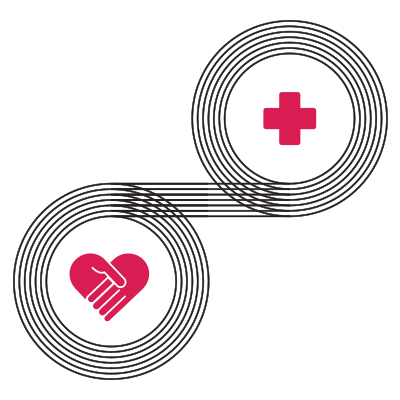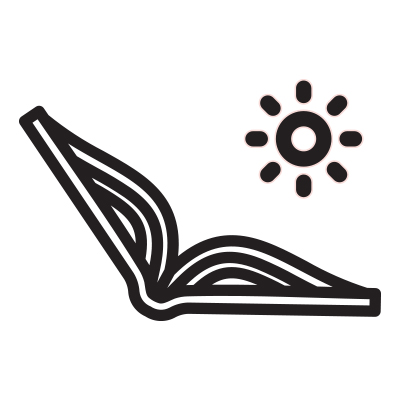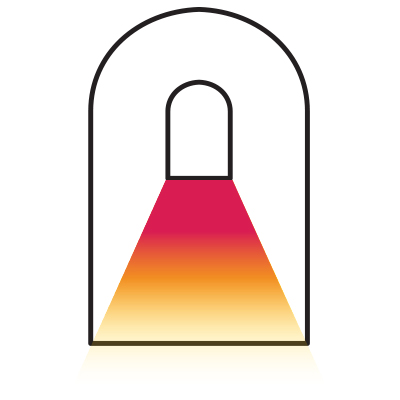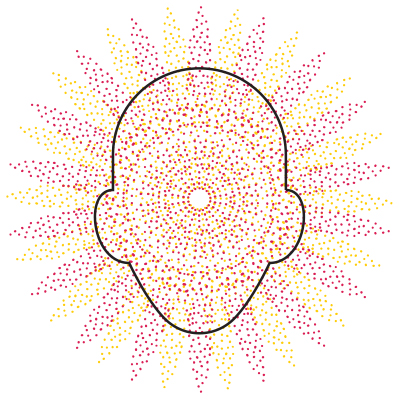
While 90% of patients with sarcoidosis — an inflammatory disease in which the immune system overreacts — experience inflammation in their lungs, the condition can also impact the heart, eyes, nervous system, kidneys, bones, joints and skin. And every person with sarcoidosis is affected differently.
“So treating patients with sarcoidosis has to be a team effort,” says Michelle Sharp, a Mary and David Gallo CIM Scholar and co-director of the Johns Hopkins Sarcoidosis Program. Since she joined the Johns Hopkins faculty in 2019, Sharp has led efforts to expand the multidisciplinary approach of the Johns Hopkins Sarcoidosis Program. This strategic approach allows patients with multiple system involvement to receive the coordinated care they need in a timelier manner. She is also leading increased efforts in scientific research, which will one day allow for the development of better treatments for the difficult-to-diagnose condition, which has no known cure.
“By the time patients come to us, many have been suffering with unexplained symptoms for years. And it’s not unusual for them to have seen more than a dozen different specialists without getting an accurate diagnosis,” says Sharp. What’s more, current treatments — primarily steroids, such as prednisone — come with unwelcome side effects, such as weight gain, diabetes and hypertension.
Further complicating the picture: There are significant health disparities associated with sarcoidosis, with worse outcomes associated among lower-income patients, Black individuals compared to White individuals and females compared to males.
“If we’re going to understand the science behind this disease and figure out the best new treatments for our patients, we’re going to need to do it as a team, and that includes working with our patients as partners,” says Sharp.
Listening to Patients
That’s exactly what unfolds now each Friday at noon, when Sharp and a wide-ranging group of Johns Hopkins physician experts — including neurologists Barney Stern and Carlos Pardo–Villamizar, cardiologist Nisha Gilotra, pulmonary hypertension specialist Stephen Mathai, pulmonologist and clinic co-director Edward Chen, and many others — meet to review and coordinate care for the 2,000-plus patients who visit the John Hopkins Sarcoidosis Program for care.
Helping patients navigate visits, which include imaging and blood tests, falls to a dedicated team including medical office and patient coordinator Terri Bennett and nurse practitioners Kayla Nyakinye and Victoria Wotorson.
Sarcoidosis often strikes patients in the prime of their lives, between ages 20 and 40, and the impact can be sudden and devastating. “I had one patient in his 20s suddenly pass out at the beach. The next thing he knew, he was in the hospital being equipped with a pacemaker,” Sharp says. “Other patients develop lung scarring that severely restricts their ability to work.
“While our internal team is important, our external team plays a vital role as well,” says Sharp, speaking of the nine-member Patient Advisory Board she established in 2020, which meets on a quarterly basis. “As we were building our capacity, it was so important to me that we hear from our patients so that we could learn firsthand their needs and the challenges they face,” she says.
“By the time patients come to us, many have been suffering with unexplained symptoms for years. And it’s not unusual for them to have seen more than a dozen different specialists without getting an accurate diagnosis.” – Michelle Sharp
The first initiative of the Patient Advisory Board was to create a Patient Support Group, which now meets the first Monday of every month to provide patients a forum to share their own experiences and connect with others. The Zoom meetings feature an informational talk by a Johns Hopkins sarcoidosis specialist, such as on managing fatigue, followed by breakout room sessions for patients to share experiences and “help patients to realize they are not alone,” she says.
Eliminating Health Inequities
While Sharp stays busy seeing patients, she notes gratefully that her Gallo Scholar funding has made it possible for her to advance work in patient education, an avenue that has personal resonance for her.
“My sister and I are the first in our family to attend college — and I’m the only professional in my family and the only physician,” she says. “I’ve had the opportunity to help navigate the health care system for my family members, and that’s helped me recognize the importance of using language that patients understand.”
She has developed a series of resources for patients to foster shared decision-making in their treatment and, working with members of the Patient Advisory Board, is currently fine-tuning an education series for patients with lower health literacy.
That work builds on research she’s conducted. Sharp co-authored the first observational study of medication adherence in sarcoidosis, which found that participants with better adherence reported better health-related quality of life.
“If we’re going to understand the science behind this disease, and figure out the best new treatments for our patients, we’re going to need to do it as a team, and that includes working with our patients as partners.” – Michelle Sharp
“One of my goals in improving clinical outcomes for patients with sarcoidosis is to eliminate health inequities,” Sharp says. “Moving forward, I would like to understand more fully what factors determine whether or not a patient takes their medications, so that we can put better support systems in place.”
Ultimately, Sharp and her colleagues aim to find a cure for sarcoidosis, or at least develop more targeted therapies with fewer side effects than those currently available.
That research mission is getting a huge boost, Sharp says, with the establishment at Johns Hopkins of a multi-disciplinary Sarcoidosis Registry, which includes a biorepository holding patient data and biological samples.
Sarcoidosis is relatively rare, “but here at Johns Hopkins we have more than 2,000 patients in our program.” she says, “Working together as a team, we are well positioned to solve the mysteries that have remained in sarcoidosis for more than 100 years.”
She adds, “Funding I have received as a Mary and David Gallo CIM Scholar has been instrumental for us to get this up and running.”
Sharp is optimistic that building a program of coordinated care and multidisciplinary research for sarcoidosis will put a cure within reach.
“My dream for our program is to have both sides of the bench — both translational and basic scientists — paired with clinicians from across disciplines and patients, all working together to move our knowledge of this disease forward,” she says. “Our patients deserve answers.”
Don Willett May 5th, 2023
Posted In:

Whether you’re unwinding at the beach, the mountains or in a hammock in your backyard this summer, here are three thought-provoking books — by authors with CIM connections — that you won’t want to miss.
The Transformative Power of the Arts
“Many of us tend to think of the arts as either entertainment or as an escape. But what this book will show you is that the arts are so much more. They can be used to fundamentally change your day-to-day life. They can help address serious physical and mental health issues, with remarkable results. And they can both help you learn and flourish.”
So write Susan Magsamen, founder and director of the International Arts + Mind Lab, and Ivy Ross, Google’s vice president of design for the hardware product area, in the introduction to their new book, Your Brain on Art: How the Arts Transform Us.
Magsamen and Ross take a broad approach, talking to fascinating people from all walks of life, including a traumatized firefighter who found solace through art, famed biologist Edward O. Wilson (before he died), musician David Byrne, and Susan’s husband, Richard Huganir, director of the Johns Hopkins Department of Neuroscience.
Magsamen, whose International Arts + Mind Lab is part of the Pederson Brain Science Institute at the Johns Hopkins University School of Medicine, is also an assistant professor of neurology at Johns Hopkins, co-director of the NeuroArts BluePrint Project in partnership with the Aspen Institute, and author of seven previous books about art and learning, many for children.
“You don’t have to be an expert or have a particular talent for art in order for it to have a tremendous positive impact on your life,” Magsamen says. “You can start right away. You don’t have to spend a lot of money.” — Karen Nitkin
Lighting the Path to Healing
“To treat, even to cure, is not always to heal.” That is the guiding credo of Johns Hopkins psychiatrist Kay Redfield Jamison’s newest book, her ninth, which offers an expansive cultural history of the treatment and healing of mental suffering.
Fires in the Dark: Healing the Unquiet Mind, due out in May, “is very much about psychotherapy. It is also about war and the trauma of war,” says Jamison, the Dalio Professor in Mood Disorders, MacArthur Foundation “Genius Grant” recipient and a 2018 Pulitzer Prize finalist for biography.
In Fires in the Dark, Jamison weaves in her own experience with bipolar illness, demonstrating how effective psychotherapy can be when it is done well. She also argues that not only patients but doctors must be healed, using as one example W.H.R. Rivers, the psychiatrist who treated poet Siegfried Sassoon and other shell-shocked World War I soldiers.
Artists and writers also have a role in our healing, Jamison notes in her book, which examines the role that Paul Robeson — bass-baritone, stage and film actor, and activist — played in helping us to heal as a people.
“Jamison’s elegant prose, imbued with personal warmth and deep humanity, is itself a solace,” writes Lori Gottlieb, New York Times best-selling author, “lighting the way on the path that leads us to a more peaceful present and imaginative future.”
Technology in Medicine: Empty Promises?
In the early days of the COVID-19 pandemic, Jeremy Greene, the Leslie and Scott Jacobs and Stephen Rosenthal CIM Scholar, like other clinicians, turned to telemedicine as a way to keep his patients at an East Baltimore community health center safe from the contagious disease.
Telemedicine wasn’t new in March 2020, but the pandemic made it ubiquitous. The technology’s grand promise, that it would increase access to care, particularly for disadvantaged people, would be tested in real time.
Greene, an internist who is director of the Department of the History of Medicine at Johns Hopkins and a member of CIM’s Advisory Committee, has long been fascinated with the powerful and often-overlooked ways that the doctor-patient relationship is mediated by technology. He quickly saw that telemedicine was tremendously useful for patients with the technology and skills to log into the electronic system and use home-based equipment like blood pressure cuffs or pulse oximeters.
But patients without those advantages lost out, he writes in The Doctor Who Wasn’t There: Technology, History and the Limits of Telehealth, his new book tracing the history of remote care.
“Telemedicine, a technology that initially promised greater access to care to patients of color in poor urban areas, had in the crisis of the early pandemic come to serve more well-to-do, white patients who needed assistance least,” Greene writes.
For his latest book, Greene steps into the way-back machine and examines how four technologies — the telephones of the 1920s, radios of the 1940s, closed-circuit televisions of the 1950s and the connected computers of the 1960s — changed health care. Grand promises to the contrary, they didn’t erase health disparities and often made them worse.
That historic perspective helps Greene see the promise of the present moment and how easily it can slip away. As his book shows, each innovation was promoted with claims that it would improve access to care, particularly for disadvantaged urban and rural patients.
However, technology alone can’t bridge the stubbornly persistent divide between medical haves and have-nots, he notes. That requires sustained logistical and financial support from politicians, the medical community and technology companies. — Karen Nitkin
Don Willett May 5th, 2023
Posted In:

When it comes to the potential for helping patients with Alzheimer’s disease, a field that for decades has been beset by dashed hopes and disappointments, Constantine Lyketsos believes there’s real reason for optimism — optimism that rests in research underway now within the Richman Family Precision Medicine Center of Excellence in Alzheimer’s Disease at Johns Hopkins, which he leads.
For most of the last two decades, Lyketsos explains, researchers have focused on the “amyloid case” — the belief that Alzheimer’s disease is caused by the accumulation of amyloid protein tangles in the brain. A variety of drugs have been developed to diminish those plaques, “and in general, while some of these drugs are pretty good at removing amyloid from the brain, these therapeutics have not been good at improving symptoms,” says Lyketsos, the Alafouzos CIM Scholar, who founded and directs the Johns Hopkins Memory and Alzheimer’s Treatment Center.
He and other researchers at Johns Hopkins are focused on a precision medicine approach. “Alzheimer’s disease and related disorders are not a single disease. We need to take a fresh look and to consider Alzheimer’s and related disorders as a series of diseases that each require a different combination of treatments,” says Lyketsos, the Elizabeth Plank Althouse Professor in Alzheimer’s Disease Research.
The precision medicine strategy is made possible, in part, by technological advances that allow for the analysis of “big data.” Researchers at the precision medicine center have access to more than 130,000 patient records drawn from patients seen at the Memory and Alzheimer’s Center and Johns Hopkins Community Physicians (“under strict oversight,” Lyketsos notes), which they are analyzing to arrive at subgroups of patients who might respond better to different treatments.
One particularly promising area under study homes in on vascular disease in the brain, now widely accepted as a cause for some forms of Alzheimer’s disease. Johns Hopkins researchers are using MRI to measure perfusion (how well blood gets distributed within the brain) in test subjects exposed to a “stress test” — in this case, exposure to carbon dioxide. Brain perfusion is measured before and after the stressor is introduced. “We’re finding that people show a range of responses. Some respond ‘properly,’ with blood flow increasing, while others have reduced perfusion,” says Lyketsos. The latter group, he notes, could represent a subgroup of patients who respond well to individualized, targeted therapies aimed at improving brain blood flow.
Paul Rosenberg, co-director of the Memory and Alzheimer’s Treatment Center Division of Geriatric Psychiatry and Neuropsychiatry, and his team are testing that idea now in animal models, administering cholesterol-reducing atorvastatin to animals with impaired perfusion. “If we can improve perfusion, perhaps we can improve memory loss,” Lyketsos says.
The ability to study and design therapeutic solutions for individual patients has taken a giant leap forward with advances in stem cell technology. It’s now possible, from a single blood sample, for researchers to develop individualized brain cell lines that can then be used in the petri dish to test responses to different drugs or treatments.
“Alzheimer’s disease and related disorders are not a single disease. We need to take a fresh look and to consider Alzheimer’s and related disorders as a series of diseases that each require a different combination of treatments.”– Constantine Lyketsos
Esther Oh, the Sarah Miller Coulson CIM/Human Aging Project Scholar, is doing just that in research examining the role that inflammation plays in the brain since this may be a target of treatments for a subset of patients. In Alzheimer’s disease, immune cells in the brain called microglial cells can get over-activated in some people, producing substances (inflammation) harmful to brain tissue. As part of the Richman Center, Oh collaborates with stem cell engineering expert Vasiliki Machairaki from the Department of Genetic Medicine. Machairaki is developing person-specific microglial cell lines to define and differentiate which individuals are more (or less) apt to have “damaging” inflammatory responses in their brains. These individualized microglial lines can also be used as testing platforms to assess the effect of promising medication that can be used to mitigate these inflammatory responses.
Machairaki is using this same approach to develop a wide variety of different brain cell lines relevant to Alzheimer’s, all derived from the stem cells of individual people (e.g., neurons, astrocytes). Additional, technological advances pioneered by Machairaki now make it possible to develop 3D culture systems, or “organoids,” that are organized in layers almost as in the native brain. These can include many different types of cells and also serve as models to study subtypes of Alzheimer’s.
“Increasingly,” says Lyketsos, “based on the test tube response of 2D and 3D models of an individual’s brain cells, we will be able to predict whether individual therapies are likely to be helpful.” These advances will significantly improve the way clinical trials are performed in the future, he notes. That’s because a promising drug can first be tested using a patient’s cell line, leading to faster selection of a subgroup of patients who are likely to respond positively.
It’s vital work, and time is of the essence. Worldwide today, more than 50 million people suffer from dementia, and nearly 10 million new cases are diagnosed every year. These numbers are projected to double by 2050.
“We still have a long way to go,” says Lyketsos, “but by pursuing precision medicine solutions, I am very excited by the prospect of being able to reach the right patient at the right time with the right treatment.”
Don Willett May 5th, 2023
Posted In:

For patients with brain tumors, the route to the radiation room can be anxiety-producing — particularly the first time, when they go to be fitted with a moldable, plastic mesh mask that will anchor their head in the same position each time they receive radiation therapy.
Annie LaVigne, chief resident in radiation oncology at The Johns Hopkins Hospital, has thought a lot about her patients. To lift their mood, she envisions them being greeted along the corridor by unique wall hangings: mesh masks-turned-art projects. “To make the process less anxiety-producing, I want to ground these foreign objects in something familiar to our patients,” she says, “something we share in common that’s unrelated to cancer, like Old Bay and crabs and the Ravens.”
This ongoing project, now funded through the Barbara and Peter Miller Scholars Personomics Initiative, began when LaVigne was a fourth-year resident and a scholar in the yearlong Health Humanities distinction track for residents and fellows at The Johns Hopkins Hospital and Johns Hopkins Bayview Medical Center. “In college, I minored in studio art, but I didn’t have much time for it once I started residency,” she says. “The track helped me find my way back to my art and connect it with improving patient care.”
A key pillar of the Health Humanities distinction track is an inquiry-based teaching method known as visual thinking strategies (VTS), which asks learners to observe and discuss visual art. The idea is to build participants’ ability to describe, analyze and interpret imagery and information, and to have them engage in collaborative discussions, which is all aimed at developing critical thinking skills.
At Johns Hopkins Medicine, psychiatrist Meg Chisolm, a member of the Miller Coulson Academy of Clinical Excellence, is a leading advocate of this approach. She says VTS gave her dramatically new ways of thinking and changed the entire course of her medical career, as she pivoted from directing Johns Hopkins’ Center for Addiction and Pregnancy to become associate director of the Paul McHugh Program for Human Flourishing, whose mission is to help clinicians practice in a more humanistic way.
“What I have come to care about most in life is art museum-based medical education,” says Chisolm, vice chair for education for the Department of Psychiatry and Behavioral Sciences. “I’ve seen its power to cultivate a sense of wonder about oneself and one’s patients, resulting in physicians who are able to deliver more humanized care.”
“What I have come to care about most in life is art museum-based medical education. I’ve seen its power to cultivate a sense of wonder about oneself and one’s patients, resulting in physicians who are able to deliver more humanized care.” – Meg Chisolm
As an example of the VTS approach, Chisolm describes a popular class she developed for medical students, called Professional Identity Transformation: An Art Museum-Based Elective.
She always begins the first class with this prompt: “Pair up. Then, choose a work of art with which to introduce yourself to your partner. After you exchange introductions, introduce your partner to the rest of the class.” Chisolm says the exercise requires students to listen attentively to their partners, and it replaces dry, formulaic introductions with ones like: “This painting reminded me of the old trumpet my father had, which inspired me to learn to play. In college, I ended up being in the marching band, which is where I met my best friend and my husband.”
“These art museum-based methods support skills important to physicians, like observation, communication, critical thinking, tolerance of ambiguity, comfort with uncertainty and personal insight.” – Meg Chisolm
In a field rife with the competitive acquisition of knowledge, where students spend years sharpening their individual acumen, Chisolm says this course increases a sense of community and reteaches the value of collaboration and teamwork.
One former student wrote, “It was amazing how someone else would point out something that I had completely missed in studying the same picture or poem.” And another noted, “Since I was young, I have always been afraid to answer questions in class because I did not want to get them wrong, but this class allowed me to express my thoughts without that kind of fear.”
“These art museum-based methods support skills important to physicians, like observation, communication, critical thinking, tolerance of ambiguity, comfort with uncertainty and personal insight,” says Chisolm, who has used VTS and other arts-based teaching methods with Johns Hopkins pre-health professions students, residents/fellows and faculty members, in addition to medical students.
She’s found the course can also help learners process the strong emotions and stressors that arise during training and medical practice. “The class helped me interrogate my feelings about my career in medicine and about patient experiences I had had,” says fourth-year medical student Diane Jung. “It gave me time and space to reflect on why I wanted to go into medicine and to realize I still had hope and found purpose in my future as a physician.” — Catherine Gara
Don Willett May 5th, 2023
Posted In: